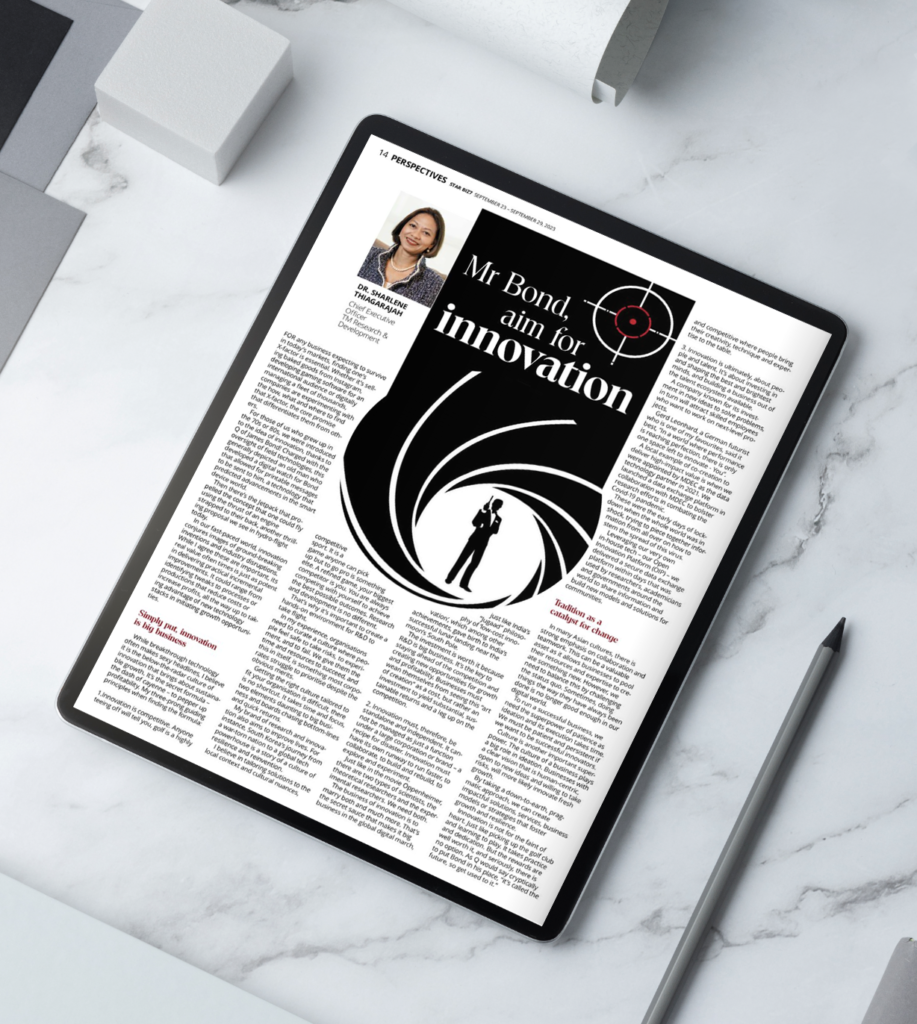
For any business expecting to survive in today’s markets, finding one’s X-factor is essential. Whether it’s selling baked goods from Instagram, developing gaming software for an international audience or digitally managing a fleet of thousands, companies are experimenting with the how, what and where to find that X-factor, the core promise that differentiates them from others.
For those of us who grew up in the 70s or 80s, we were introduced to the idea of innovation, thanks to Q of James Bond! Charged with the oversight of field technologies, this generally depicted an old man who developed a digital watch for Bond that allowed for printable messages to be sent to him, a technology that predicted advancements in the smart device world.
Then there’s the Jetpack that propelled the concept that one could fly using the thrust of an engine strapped to their back, another thrilling proposal we see in hydro-flight today.
In our fast-paced world, innovation conjures images of ground-breaking inventions and industry disruptions. While I agree these are important, its real value often times is just as potent in delivering practical incremental improvements. It could range from identifying tweaks to processes or productions that reduce costs or increase profits, all the way up to taking advantage of new technology stacks in initiating growth opportunities.
Simply put, innovation is big business
While breakthrough technology often makes sexy headlines, I believe it is the below-the-radar culture of innovation that brings about sustainable growth. It’s the secret formula – the dash of cayenne – to pepper up profitability. My three-prong guiding principles when finding the formula:
- Innovation is competitive. Anyone teeing off will tell you, golf is a highly competitive sport. It is a game anyone can pick up but to go pro is something else. A refined game, your biggest competitor is you. You are always competing with yourself to achieve the best possible outcomes. Research and development is no different.
That’s why it's important to create a hands-on environment for R&D to take flight. In my experience, organisations need to curate a culture where people feel safe to take risks, to experiment, and to fail. We give them the time and resources to succeed, and this in itself, something most corporates struggle to prioritise despite the obvious merits.
Getting the right culture tailored to fit your organisation is difficult, there is no shortcut. It takes time and focus, two elements daunting to big business and boards chasing bottom-lines and quick returns.
My brand of research and innovation also aims to improve lives. For instance, South Korea's journey from a war-torn nation to a global tech powerhouse is a story of a culture of resilience and reinvention. I believe in tailoring solutions to the local context and cultural nuances, just like India's "Jugaad" philosophy of 'low-cost innovation', which among other achievements, gave birth to India's successful lunar landing near the moon's South Pole.
The investment is worth it because R&D is big business. It's the key to staying ahead of the competition and creating new opportunities for growth and profitability. Businesses must wean themselves from seeing this “art of creation” as a cost, but rather an investment to yield substantial, sustainable returns and a leg-up on the competition.
- Innovation must, therefore, be standalone and independent. It cannot be managed as just a function under a large corporation or brand – a recipe for disaster. Innovation must have its own runway to run faster, to collaborate, to build and rebuild, to explore and experiment.
Just like in the movie Oppenheimer, there are two types of scientists, the theoretical researchers and the experimental researchers. We need both. The business of innovation is to marry both and much more. That's the secret sauce that makes it big business in the global digital march, and competitive where people bring their creativity, technique and expertise to the table.
- Innovation is ultimately, about people and talent. It's about investing in and shaping the best and brightest minds, and building a business out of the talent ecosystem available. A company known for its investment in new ideas to solve problems, in turn will attract skilled employees who want to work on next-level projects.
Gerd Leonhard, a German futurist who is one of my favourites, said it best, “In a world where performance is reaching perfection, there is only one space left to innovate - You”.
A local example of co-creation to deliver high-impact value is when we were appointed by MDEC as the Data Technology Partner in 2021. We launched a Data Exchange Platform in collaboration with MDEC to bolster research efforts in combating the COVID-19 pandemic.
These were the early days of lock-down when the whole world was in shock, trying to piece together information from all over on how to stem the spread of this virus. Leveraging our very own in-house tech – our Open Innovation Platform (OIP) – we delivered a secure data exchange platform within days that was used by researchers, academicians and governments around the world to share information and build new models and solutions for communities.
Tradition as a catalyst for change
In many Asian cultures, there is a strong emphasis on collaboration and teamwork. This can be a valuable asset, as it allows businesses to pool their resources and expertise to create something new. However, we need to balance this by challenging the status quo. Sometimes, doing things the way they have always been done is no longer good enough in our digital world.
To run a successful business, we need the superpower of patience as ideation and its execution takes time. We must be patient and persistent if we want to be successful innovators.
Culture is another important superpower. The culture of a business plays a big role in ideation. Businesses with a clear vision that is human-centric, open to new ideas and willing to take risks, will more likely innovate fresh growth.
By taking a down to earth, pragmatic approach, we can create impactful solutions, services, business models or strategies that foster growth and resilience.
Innovation is not for the faint of heart. Just like picking up the golf club and learning to play, it takes practice and dedication. But the rewards are well worth it, and seriously, there is no option. As Q would say cryptically to put Bond in his place, “it’s called the future, so get used to it.”
Behind every great company, is its people.
This article has been published in the Star Biz 7, Issue 11 - India's Rising.
To access the PDF version, Click Here
To read the full magazine, Click Here

